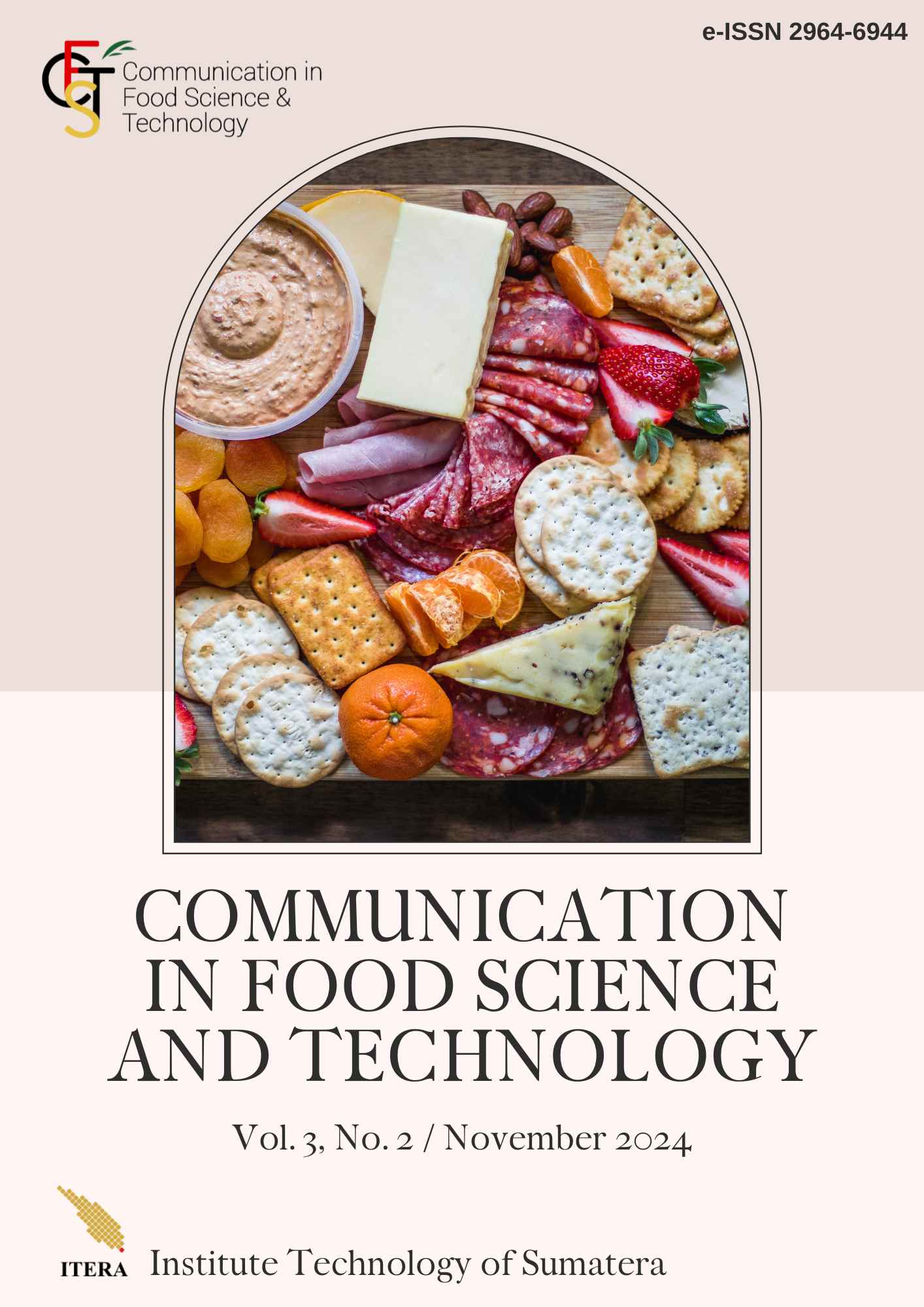Analysis of Vitamin A Content and Antioxidant Test in Super and Bulk Olein
Abstract
Cooking oil is the essential food for bodies. Cooking oil should be enriched with vitamin A because this substance plays a critical role in maintaining health. Cooking oil contains antioxidant compounds, which inhibit or slow down oxidation reactions. This study aimed to determine the amount of vitamin A in super olein and bulk olein before fortification and the amount of antioxidant content in super olein and bulk olein before fortification. The amount of vitamin A content was obtained using the High-Performance Liquid Chromatography (HPLC) method of <0.005 IU/gram, while the antioxidant test results were carried out by the 2,2-Diphenyl-1-picrylhydrazyl (DPPH) method using UltraViolet-Visible Spectrophotometry (UV-Vis). The resulting antioxidant activity has an inhibition value of 23% and 10% in bulk and super olein, respectively. Cooking oil is the essential food for bodies. Cooking oil should be enriched with vitamin A because this substance plays a critical role in maintaining health. Cooking oil contains antioxidant compounds, which inhibit or slow down oxidation reactions. This study aimed to determine the amount of vitamin A in super olein and bulk olein before fortification and the amount of antioxidant content in super olein and bulk olein before fortification. The amount of vitamin A content was obtained using the High-Performance Liquid Chromatography (HPLC) method of <0.005 IU/gram, while the antioxidant test results were carried out by the 2,2-Diphenyl-1-picrylhydrazyl (DPPH) method using UltraViolet-Visible Spectrophotometry (UV-Vis). The resulting antioxidant activity has an inhibition value of 23% and 10% in bulk and super olein, respectively.
Downloads
References
[2] E. L. Nampeera, H. W. Kayondo, T. M. Sebikeje, G. Ddumba, S. Mubiru, and D. Gabriel, “Farmers’ pest management strategies in oil palm production in Lake Victoria Islands, Uganda,” Agric Syst, vol. 227, no. April, p. 104354, 2025, doi: 10.1016/j.agsy.2025.104354.
[3] J. J. John Martin et al., “Deciphering the molecular mechanisms of oil palm lipid metabolism through combined metabolomics and transcriptomics,” Food Chem, vol. 482, no. April, p. 144154, 2025, doi: 10.1016/j.foodchem.2025.144154.
[4] C. Reich and O. Musshoff, “Oil palm smallholders and the road to certification: Insights from Indonesia,” J Environ Manage, vol. 375, no. October 2024, p. 124303, 2025, doi: 10.1016/j.jenvman.2025.124303.
[5] A. J. Astari, J. C. Lovett, and M. Wasesa, “Sustainable pathways in Indonesia’s palm oil industry through historical institutionalism,” World Development Sustainability, vol. 6, no. 229, p. 100200, 2025, doi: 10.1016/j.wds.2024.100200.
[6] A. A. Sulaiman, A. Amruddin, A. H. Bahrun, K. Yuna, and M. Keela, “New Challenges and Opportunities of Indonesian Crude Palm Oil in International Trade,” Caraka Tani: Journal of Sustainable Agriculture, vol. 39, no. 1, pp. 94–106, 2024, doi: 10.20961/carakatani.v39i1.81957.
[7] A. Imdad et al., “Vitamin A supplementation for preventing morbidity and mortality in children from six months to five years of age.,” Cochrane Database Syst Rev, vol. 3, no. 3, p. CD008524, Mar. 2022, doi: 10.1002/14651858.CD008524.pub4.
[8] I. Ayu, M. Pratiwi, I. A. Pratiwi, P. Yasa, N. Sepiawati, and M. F. Nastiar, “how mother’s education shape children development in Indonesia?,” pp. 7–23, Jan. 2025.
[9] B. F. Rahmiati, M. T. Jauhari, W. C. Naktiany, J. Ardian, and R. P. Yunika, “Hubungan Status Gizi dan Konsumsi Pangan Sumber Antioksidan dengan Tingkat Morbiditas Biomarker Covid-19,” Nutriology : Jurnal Pangan,Gizi,Kesehatan, vol. 2, no. 2, pp. 23–29, 2021, doi: 10.30812/nutriology.v2i2.1649.
[10] H. Haryoto, A. Frista, J. Achmad Yani Tromol Pos, P. Kartasura, J. Tengah, and J. Sains dan Kesehatan, “Aktivitas Antioksidan Ekstrak Etanol, Fraksi Polar, Semipolar dan Non Polar dari Daun Mangrove Kacangan (Rhizophora apiculata) dengan Metode DPPH dan FRAP,” Jurnal Sains Kesehatan, vol. 2, no. 2, 2019, doi: 10.25026/jsk.v2i2.129.
[11] L. Fei, D. Zhang, Y. Mao, and J. Johari, “Metabolomics combined with network pharmacology reveals the regional and variety heterogeneity of grape metabolites and their potential antioxidant mechanisms,” Food Research International, vol. 211, no. April, p. 116443, 2025, doi: 10.1016/j.foodres.2025.116443.
[12] J. Cao, H. Yan, B. Ye, Y. Shen, and L. Liu, “Mechanistic insights into the impact of Maillard reaction products on endogenous antioxidant systems in fish muscle,” Future Foods, vol. 11, no. February, 2025, doi: 10.1016/j.fufo.2025.100623.
[13] N. Isnaeni, “Uji Aktivitas Antioksidan dengan Metode Peredaman Radikal Bebas 2,2-Diphenyl-1-Pilcryhdrazyl (DPPH),” Aug. 2021.
[14] H. Soni et al., “From kitchen to cosmetics: Study on the physicochemical and antioxidant properties of waste cooking oil-derived soap,” J King Saud Univ Sci, vol. 36, no. 10, p. 103483, 2024, doi: 10.1016/j.jksus.2024.103483.
[15] J. L. Teh, R. Walvekar, K. C. Ho, and M. Khalid, “Biolubricants from waste cooking oil: A review of extraction technologies, conversion techniques, and performance enhancement using natural antioxidants,” J Environ Manage, vol. 375, no. October 2024, 2025, doi: 10.1016/j.jenvman.2025.124267.
[16] G. Pande, C. C. Akoh, and O.-M. Lai, “19 - Food Uses of Palm Oil and Its Components,” O.-M. Lai, C.-P. Tan, and C. C. B. T.-P. O. Akoh, Eds., AOCS Press, 2012, pp. 561–586. doi: https://doi.org/10.1016/B978-0-9818936-9-3.50022-8.
[17] G. G. Rimkus, M. Schubert, D. Morgan, and S. Jungjohann, “Rapid direct analysis of retinyl palmitate (vitamin A) in fortified vegetable oils by HPLC-FLD.,” Food Addit Contam Part A Chem Anal Control Expo Risk Assess, vol. 39, no. 1, pp. 24–34, Jan. 2022, doi: 10.1080/19440049.2021.1977854.
[18] H. A. Hasibuan and D. Siahaan, “Review Standar Minyak Goreng Sawit Diperkaya Karoten terkait Fortifikasi Vitamin A sebagai Revisi SNI SNI 01-3741-2002,” 2014. [Online]. Available: https://api.semanticscholar.org/CorpusID:100672787
[19] A. Fitriana, A. Rosidi, T. Ria Pakpahan, and P. Studi Gizi Fakultas Keperawatan dan Kesehatan, “Gambaran Asupan Vitamin Sebagai Zat Antioksidan Atlet Sepakbola di Pusat Pendidikan dan Latihan Pelajar Jawa Tengah di Salatiga,” Gizi, Universitas Muhammadiyah Semarang, vol. 3, no. 1, Apr. 2014.
Copyright (c) 2024 Desi Riana Saputri, Yuniar Luthfia Listyadevi, Muhammad Alparidi Pamungkas Putra, Muhammad Triyogo Adibowo, Andri Sanjaya, Damayanti Damayanti, Wika Atro Auriyani, Yunita Fahni, Fauzi Yusupandi, Reni Yuniarti, Edwin Rizki Safitra

This work is licensed under a Creative Commons Attribution-NonCommercial 4.0 International License.












